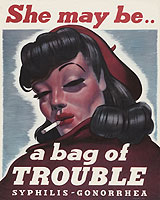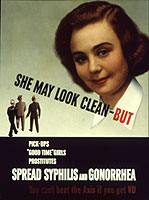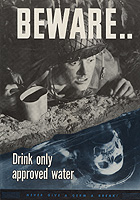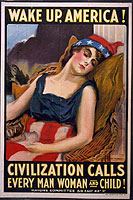Product links support this website. Details.
Never underestimate the value of the U.S. government when it comes to surreal and absurd images, many of which are in the public domain.
I mean it. And, if you’re easily offended, or if the subject of VD bothers you, avert your eyes.
 Seriously, this poster (at right) appears to be in the public domain. (See notes at the U.S. National Library of Medicine.) You can download a 4MB copy of it at the gov’t website.
Seriously, this poster (at right) appears to be in the public domain. (See notes at the U.S. National Library of Medicine.) You can download a 4MB copy of it at the gov’t website.
I can see so many very wrong uses for that image. I’d like to put it on a tee shirt, except that I want to replace the VD words with… something else. I’m not sure what, yet.
I look at her and think, “Really? I mean really? Is that what men found alluring in the 1940s?”
However, that’s not the only image of its kind. A search at the gov’t website using the phrase “venereal disease” turns up all kinds of strange posters of apparently dangerous women.
 Check out the sweet girl in the poster on the left. (Click on the image for the full, print-quality image at the NLM.)
Check out the sweet girl in the poster on the left. (Click on the image for the full, print-quality image at the NLM.)
Wasn’t she a famous movie star? She looks really familiar… like someone I’ve seen in old movies. Well, now we know about her history!
I’m amused by the phrase “‘good time’ girls.” It makes me wonder, were there “bad time” girls?
That poster is in the public domain.
 The next poster for your consideration (or amusement) is about clean water. Gosh, it looks like our boys were dealing with all kinds of dangers in the 1940s… wasn’t war enough?
The next poster for your consideration (or amusement) is about clean water. Gosh, it looks like our boys were dealing with all kinds of dangers in the 1940s… wasn’t war enough?
Because that was produced specifically for government use, I’m pretty sure it’s in the public domain.
Click the image to see a really large copy of it. There may be even bigger versions in the NLM files.
(Of course, if you’re going to use it for a product, it’s smart to research the provenance at the NLM website.)
 And, so it’s not all one-step-away-from-zombies, at left is an early poster that has a lot of possibilities if you’d like to alter it for a political statement.
And, so it’s not all one-step-away-from-zombies, at left is an early poster that has a lot of possibilities if you’d like to alter it for a political statement.
This one is from 1917, so it’s almost certainly in the public domain. (Most – but not all – American works from before 1923 are now in the public domain.)
If you have questions about copyright law and what’s in the public domain, one of my favorite resources is Cornell’s chart about copyright terms and limits.
Amazon and the Amazon logo are trademarks of Amazon.com, Inc, or its affiliates. As an author and affiliate, I may earn a small commission if you purchase anything through my links. That does not affect the item's price, and I only link to products that I use and like, myself.
